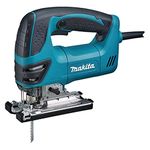Picking a Portable Table Saw
Small enough to carry, big enough to rip green 2x12s, accurate enough for finish work.

Synopsis: This tool survey compares the specifications, features, and cutting performance of 13 portable table saws ranging in price from $130 to $520. Included are discussions of rip fences, miter gauges, ripping capacity, saw stands, blade guards, and tilting mechanisms, as well as recommendations for entry-level, mid-range, and high-end saws.
As a finish carpenter, I depend on my table saw as much as any other tool I own, almost more than my truck. Recently, my old turquoise table saw (you know the one) gave up the ghost. I had to replace it, but when I went shopping, I was stunned by the number of portable table saws now on the market. In this article, I’ll share what I learned about all these saws.
Three classes of saws
I found 13 table saws that can be called portable (easily carried by one person), and these saws fall into three basic classes that I call entry-level, midlevel and high-end saws. Entry-level saws are the least expensive and the lightest. They weigh 30 lb. to 40 lb. and range in price from $130 to $260. Entry-level saws include the Skil, Delta’s Bench Saw, Pro-Tech, Grizzly and Tradesman. (I tested an entry-level Sears Craftsman saw that was discontinued before this article went to press. Sears was planning to release a new midlevel saw about the time this issue went to press.)
Midlevel saws are bulkier and weigh 40 lb. to 60 lb. These saws cost from $250 to $350, and include Makita’s 8 1⁄4-in. and 10-in. models, the Hitachi, Delta’s Sidekick and the Powermatic.
Finally, there are the high-end saws. Weighing in at 60 lb. or more, these saws barely qualify as portable, at least for this 40-something-year-old carpenter. As you might expect, their prices are also the heaviest, all in the $500 range. The high-end saws include the DeWalt, the Ridgid and the Bosch.
Putting table saws to the test
I began my comparisons with a list of objective items such as price, weight, amps, speed, blade size and maximum rip capacity. But other features of the tools were more subjective. Rip fences, tabletops, miter gauges, blade guards, blade depth and tilt adjustments varied greatly even within each level. I also looked at two additional elements of each saw, noise and vibration. Noise was easy to quantify by using a decibel meter and carefully duplicating the set-up for each saw. But I judged vibration inductively by observing a cup of coffee placed on the saw table while the saw was running. Although vibration is more of a nuisance factor, I found that the amount of vibration translated directly to how smoothly each saw cut: the more vibration, the rougher the cut.
To keep the playing field even, I used a new, thin-kerf, 40-tooth carbide blade to test each saw. I put each saw through exactly the same rigors: cutting 3⁄4-in. melamine, 3⁄4-in. medium-density fiber-board, 3⁄4-in. oak and 2x framing lumber. I didn’t use a power feeder, instead relying on my own experience to push material evenly through the blade. I noted any saw that bogged down while cutting 2x lumber.
For more photos and details, click the View PDF button below:
Fine Homebuilding Recommended Products
Fine Homebuilding receives a commission for items purchased through links on this site, including Amazon Associates and other affiliate advertising programs.

Makita Top-Handle Jigsaw (4350FCt)

Homebody: A Guide to Creating Spaces You Never Want to Leave

BOSCH Compact Router (PR20)






















